Pomona College
Pomona College is a private liberal arts college in Claremont, California. It was established in 1887 by a group of Congregationalists[7] who wanted to recreate a "college of the New England type" in Southern California, and in the 1920s, it became the founding member of the Claremont Colleges consortium.
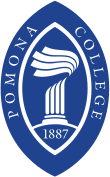 | |
| Type | Private liberal arts college |
|---|---|
| Established | October 14, 1887 |
Academic affiliations | |
| Endowment | $2.325 billion (2019)[1] |
| Budget | $229 million[2] |
| President | G. Gabrielle Starr |
Academic staff | 240[3] |
Administrative staff | 271[4] |
| Undergraduates | 1,671[5] |
| Location | , , United States 34°05′53″N 117°42′50″W |
| Campus | Suburban, 140 acres (57 ha) |
| Colors | Blue and gold[6] |
| Nickname | Sagehens |
Sporting affiliations | NCAA Division III – SCIAC |
| Mascot | Cecil the Sagehen |
| Website | www |
Pomona is a four-year undergraduate institution, and enrolled approximately 1,700 students as of fall 2019.[8] The college offers 48 majors and 600 courses, though students have access to more than 2000 additional courses at the other Claremont Colleges.[9] The college's 140-acre (57 ha) main campus is in a residential community near the foothills of the San Gabriel Mountains.
Pomona has the lowest acceptance rate of any U.S. liberal arts college (7.6% for the 2018 admissions cycle),[10][11] and is ranked among the top five liberal arts colleges in the country by Forbes, U.S. News & World Report, and the Wall Street Journal/Times Higher Education ranking.[12][13][14] It has an endowment of $2.33 billion as of June 2019, giving it the seventh-highest endowment per student of any college or university in the U.S.[15][16] In 2020, Niche ranked Pomona as the most diverse college or university in the country;[17] among enrolled students, 74% hail from out of state, 56% receive need-based financial aid, and 61% identify as a person of color or an international student.[18][19][20][21]
Pomona has approximately 25,000 living alumni,[5] with particularly strong representation in entertainment and the media.[22] Prominent alumni include Oscar, Emmy, Grammy, and Tony award winners; U.S. Senators, ambassadors, and other federal officials; Pulitzer Prize recipients; billionaire executives; National Academies members; and Olympic athletes. The college is a top producer of Fulbright Students and recipients of other fellowships.[23][24][25][26]
History
Founding era
Pomona College was established as a coeducational institution on October 14, 1887, amidst a real estate boom precipitated by the arrival of a transcontinental railroad to Southern California.[29] Its founders, a regional group of Congregationalists, sought to create "a college of the New England type".[30] Classes first began at Ayer Cottage, a rental house in Pomona, California, on September 12, 1888, with a permanent campus planned at Piedmont Mesa four miles north of the city.[31] That year, as the real estate bubble burst, making the Piedmont campus untenable, the college was offered the site of an unfinished hotel (today's Sumner Hall[28]) in nearby Claremont; it moved there[31] but kept the Pomona name.[32] Trustee Charles B. Sumner led the college during its first years, helping hire its first official president, Cyrus G. Baldwin, in 1890.[31][33] The college’s first graduating class, in 1894, had 11 members.[34][35]
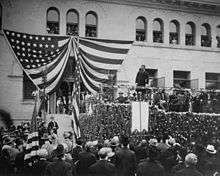
Pomona suffered through a severe financial crisis during its early years but managed to survive,[28][34][37] raising enough money to add several buildings to its campus. Although the college's first Asian and black students enrolled in 1897[38] and 1900,[39] respectively, Pomona remained almost all-white throughout its early years.[34] In 1905, during president George A. Gates' tenure, the college acquired a 64-acre parcel of land to the college's east, known as the Wash.[40] In 1911, the college eliminated its preparatory department, which had taught high school-level courses.[41] The following year, it committed to a liberal arts model,[42] soon after turning its previously separate schools of art and music into departments within the college.[43] Daily attendance at chapel was mandated until 1921,[44] and a strong athletic culture[45] and fraternity system developed.[46] During World War I, the college oriented itself towards the war effort.[47][48]
Interwar years
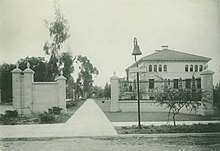
In the early 1920s, the college’s growth led its president, James A. Blaisdell, to call for "a group of institutions divided into small colleges—somewhat of an Oxford type—around a library and other utilities which they would use in common." This would allow Pomona to retain its small, liberal arts-focused teaching while gaining the resources of a larger university. On October 14, 1925, Pomona’s 38th anniversary, the Claremont Colleges were incorporated.[49][50] This decade also saw the start of construction of the Clark dormitories north of 6th St., a reflection of president Charles Edmunds' prioritization of the college's residential life.[51][52] Edmunds, who had previously served as president of Lingnan University in China, also inspired a growing interest in Asian culture at the college.[51]
| External image | |
|---|---|
Pomona's enrollment and budget declined during the Great Depression,[54][55] and it once again oriented itself towards wartime activities during World War II.[56][57][53][58]
Postwar transformations
Pomona's longest-serving president, E. Wilson Lyon, guided the college through a transformational period from 1941 to 1969.[56] Following the war, Pomona's enrollment rose above 1000,[59] leading to the construction of several new residence halls and science facilities.[60] Its endowment also grew steadily, due in part to the introduction in 1942 of a deferred giving fundraising scheme pioneered by Allen Hawley called the Pomona Plan, where participants receive a lifetime annuity in exchange for donating to the college upon their death.[58] The plan's model has since been adopted by many other colleges.[61][62]
| External images | |
|---|---|
Lyon made a number of progressive decisions relating to civil rights, including supporting Japanese-American students during internment[64][65][57] and establishing an exchange program with historically black Fisk University in Tennessee in 1952.[66] He also ended the gender segregation of Pomona's residential life, first with the opening of Frary Dining Hall (then part of the men's campus) to women beginning in 1957[63] and later with the introduction of co-educational housing in 1968.[67] However, he wavered when it came to some of the more radical student protests against the Vietnam War, and permitted Air Force recruiters to come to campus in 1967.[68][69] Pomona's previously conservative student body quickly liberalized during this era,[56][69] and its ethnic diversity also began to increase.[45][70] In 1969, a bomb exploded at Carnegie Hall, permanently injuring a secretary; no culprit was ever identified.[71][70]
During the tenure of president David Alexander from 1969 to 1991, Pomona gain increased prominence on the national stage,[72] acquiring its present reputation as the premier liberal arts college in the West.[73] The endowment also increased ten-fold, enabling the construction and renovation of a number of buildings.[70] Several identity-based groups, such as the Pomona College Women's Union (founded 1984[74]), established themselves.
In 1991, the college converted the dormitory basements used by fraternities into lounges, hastening a lowering of the profile of Greek life on campus.[75]
21st century
In the 2000s under president David W. Oxtoby, Pomona began placing more emphasis on reducing its environmental impact,[76] committing in 2003 to obtaining LEED certifications for new buildings[77][78] and launching various sustainability initiatives.[77] The college also committed to a need-blind admission policy and to meeting the full demonstrated financial need of students through grants rather than loans in 2008,[79] resulting in higher numbers of low-income and minority students enrolling.
In 2008, Pomona stopped singing its alma mater at convocation and commencement after it was discovered that the song may have been originally written to be sung as the ensemble finale to a student-produced blackface minstrel show performed on campus in 1909 or 1910. Many alumni protested the move.[80][76]
In 2011, the college drew national media attention when it requested proof of legal residency from employees in the midst of a unionization drive by dining hall workers.[81][82] 17 workers who were unable to provide documentation were fired;[83][81] the dining hall staff voted to unionize in 2013.[84]
A controversial 2013 rebranding initiative sought to emphasize students' passion and drive.[85]
In July 2017,[86] G. Gabrielle Starr became Pomona's tenth president; she is the first woman and first African American to hold the office.[87]
Campus
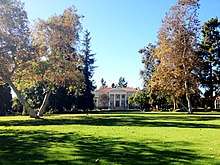
Pomona's campus is in Claremont, California, covering an area of 140 acres (57 ha) on the alluvial fans from San Antonio Canyon in the San Gabriel Mountains five miles (8.0 km) to the north.[88] It is located directly northwest of the Village, Claremont's downtown commercial district, and south of the other Claremont Colleges.
In its early years, Pomona quickly expanded from its initial home in Sumner Hall, constructing several new buildings to accommodate its growing enrollment and ambitions. After 1908, development of the campus was guided by master plans from architect Myron Hunt, who envisioned a central quadrangle flanked by buildings connected via visual axes.[89] In 1923, landscape architect Ralph Cornell expanded on Hunt's plans, envisioning a "college in a garden" defined by native Southern California vegetation.[89] James Blaisdell's decision to purchase undeveloped land around Pomona while it was still available later gave the college room to grow and found the consortium.[90] Many of the earlier buildings were constructed in the Spanish Renaissance Revival and Mission Styles, and are of only one or two stories in height.[91] Later buildings took inspiration from these styles, encompassing usually three or fewer stories bounded by stucco walls.
The campus today consists of 63 buildings, including 16 residence halls. It is bounded by First Street on the south, Mills and Amherst Avenues on the east, Eighth Street on the north, and Harvard Avenue on the west. It is informally divided into North Campus and South Campus by Sixth Street, with most academic buildings in the western half and a naturalistic area known as the Wash in the east.
South Campus
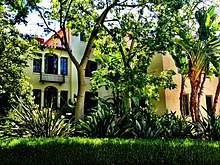
South Campus consists of mostly first-year and sophomore housing and academic buildings for the social sciences and humanities. Among the notable dormitories are Harwood Court, originally a women’s dorm built in 1921, and Oldenborg Center, a foreign language housing option for students that includes a foreign language dining hall.[92][93] Sumner Hall, Pomona’s first building and the home of admissions, financial aid, and housing, is directly across from the dormitories.
Bridges Auditorium (referred to as "Big Bridges" to distinguish it from the smaller Bridges Hall of Music) is used for concerts and speakers and has a capacity of 2,500.[94] Bridges Hall of Music ("Little Bridges"), to the east of the department of music, is a concert hall built in 1915 with seating for 600.[91] On the western edge of campus is the Benton Museum of Art, which has a small collection of European, pre-Columbian, and American works along with a gallery for traveling exhibitions.[95] The Carnegie Building houses the Politics and Economics departments. It was built in 1929 as a library for the college. Marston Quadrangle serves as a central artery for South campus facilities and is between the Carnegie Building and Bridges Auditorium. It is one of two quadrangles on campus.
Along the south side of Sixth Street are buildings central to the campus. Smith Campus Center is home to many student services, including a mailroom, a recreation room, The Coop Store, and two restaurants;[88] Alexander Hall houses administrative offices.
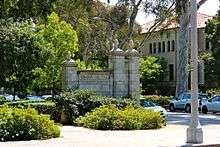
At the intersection of 6th St. and College Ave. are the college gates, built in 1914, which mark the historical northern terminus of the campus. They bear two quotes from Blaisdell. On the north is "let only the eager, thoughtful and reverent enter here", and on the south is "They only are loyal to this college who departing bear their added riches in trust for mankind". Per campus tradition, enrolling students walk south through the gates during orientation and seniors walk north through the gates shortly before graduation.[96][97]
The less-developed eastern portion of campus is known as the Wash (formally Blanchard Park[98]),[40] and contains a large grove of coast live oak trees, as well as many athletic facilities. It is also home to the Sontag Greek Theatre, an outdoor amphitheater; the Brackett Observatory; the Pomona College Organic Farm, an experiment in sustainable farming; and the Seaver Theatre Complex, built in 1990 with a 335-seat auditorium, 100-seat experimental theater and several other studios and rehearsal spaces. The Studio Arts Hall, built in 2015 to Leed Gold Certification, is behind the Oldenborg Center, and garnered national recognition for its steel-frame design.[99][100]
The athletic facilities are to the south of Sixth Street and to the east of Smiley Hall. The Rains Center is the main athletic facility with a fitness center, gym and locker rooms. Adjacent to Rains Center is Merritt Football Field, Alumni Baseball Field and Haldeman Pool. A parking structure on First Street serves as a parking space for 600 vehicles and a soccer and lacrosse field.[101]
The southern side of campus is next to the Claremont Village, the city's main commercial district, and two blocks north of the Claremont Metrolink Station.
North Campus
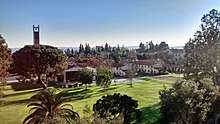
North Campus is also a mix of residential and academic buildings. Most of the academic buildings house science departments. Among the notable buildings are the Richard C. Seaver Biology Building ("Seaver West"), completed in 2005,[102] the Lincoln and Edmunds buildings, both completed in 2007, the Sontag and Dialynas residence halls, both completed in 2011, and the Millikan Laboratory for Math, Physics, and Astronomy, completed in 2015. North Campus is also home to the Center for Creativity and Collaboration, established in 2015 and colloquially termed as "The Hive".[103]
The Lincoln and Edmunds academic buildings were the first buildings in Claremont to garner a gold certification award from the U.S. Green Building Council’s Leadership in Energy and Environmental Design (LEED) Program.[104][105] They also house Dividing the Light, a skyspace by renowned artist and alumnus James Turrell '65.[106][107] Dialynas and Sontag Hall were built to LEED platinum standards, only the second large-scale residence halls in the country to earn that designation by their completion time.[108] Millikan Hall is the first LEED platinum certified science building on campus.[109]
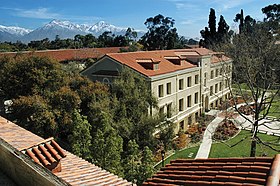
North Campus dormitories house mostly juniors and seniors. Smiley Hall was built in 1908; the college claims that it is the oldest lived-in dorm in the Western United States.[110][111] Frary Dining Hall, one of two dining halls on campus, is the location of the murals Prometheus by José Clemente Orozco, his first work in the U.S., and Genesis by Rico Lebrun.
Other facilities
The college also owns the Trail Ends Ranch (a wilderness area in the Webb Canyon north of campus)[112][113] and built a retreat center—Halona Lodge in Idyllwild, California[114]—in 1931.[115] The astronomy department built and operates a telescope at the Table Mountain Observatory.[116]
Along the north side of campus are several joint buildings maintained by The Claremont Colleges Services. These include the Tranquada Student Center, home to student health and psychological services, Campus Safety, and the Huntley Bookstore. Honnold-Mudd Library, the consortium's main library, holds 2 million volumes, 60,000 periodicals, 30,000 reels of microfilm, and over 1 million microfiche and microcards.[117] The consortium also owns the Robert J. Bernard Field Station north of Foothill Boulevard.
Academics and programs
Pomona operates on a semester system.[46] Students generally enroll in four full-credit courses each semester, though they can take up to six provided they have good academic standing. Thirty-two credits are needed to graduate from the college, along with the requirements of a major, the first year Critical Inquiry seminar, six courses within the "Breadth of Study" area requirements, proficiency in foreign language, two physical education courses, a writing intensive course, a speaking intensive course, and an analyzing difference course (the last three can fulfill the Breadth of Study or major course requirements simultaneously).[118]

The average class size at Pomona is 15. Of the 404 traditional courses (i.e., excluding thesis, lab sections, and independent study courses) at Pomona offered in Fall 2017, 93% had under 30 students, and only two courses had 50 or more students.[3] All classes are taught by professors, and there is an 8:1 ratio of students to full-time professors.[119] Eighty-five percent of faculty live within five miles (8.0 km) of campus, and each faculty member has two meal swipes each week, which they often use to interact with students.[120]
Any student attending Pomona can take up to 50% of their classes at the other four colleges in the Claremont Colleges. This policy is similar across the Claremont Colleges system; this concept is meant to give students the resources of a larger university while maintaining the positive qualities of a small liberal arts college. The academic calendars and registration procedures across the colleges are synchronized and consolidated, and there are no additional fees for taking courses at another college. In total, Pomona students have access to over 2,700 courses each year, including graduate level courses at the Claremont Graduate University and Keck Science Institute.[121] In addition, students from any department can create independent study courses evaluated through the guidance of individual faculty mentors, with a limit of one course per semester in the first and second year, and two per semester in the third year and after.[122]
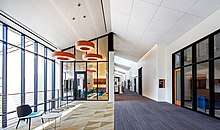
Pomona has 48 majors and 44 minors; students who would like to create their own major are eligible to do so following specific guidelines. The 10 most popular declared majors for Fall 2018, in order, are: Economics (118 students), Computer Science (91), Mathematics (67), Neuroscience (58), Politics (42), International Relations (41), Public Policy Analysis (41), Molecular Biology (39), Media Studies (38), and Psychology (32). The most popular major for Class of 2018 graduates was Economics, and approximately 15% of them received a double-major.[123] While engineering is not directly offered by the college, students are eligible to cross-register at Harvey Mudd College or to pursue a combined engineering plan in collaboration with California Institute of Technology, Washington University in St. Louis, and Dartmouth College. Pomona College also offers a teaching credential program with the Claremont Graduate University and is a partner school with the Harvard Business School HBX-CORe program.[124][125]
49% of Pomona students study abroad.[126] Pomona offers 62 pre-approved programs in 34 countries.[127] Students can study abroad in any major, and can petition to study abroad in an outside program. The college has a semester study-away program in Washington D.C. and the Silicon Valley offered through consortium member Claremont McKenna College, as well as a semester program in environmental science sponsored by the Marine Biological Laboratory. In addition, students can do a semester-exchange at Colby College, Spelman College, and Swarthmore College.[128]
Pomona spent an average of $300,095 in educational spending per degree completion as of 2013, ranking it the highest among all peer liberal arts colleges for educational spending per capita and in the top 25 of all four-year private non-profit colleges and universities. For comparison, the average California four-year private non-profit spent $125,902, and the average among all four-year private non-profits in the US was $101,725.[129]
Professional development
The majority of faculty work with one or more students on research projects in a variety of academic disciplines.[130] 53% of students do research with faculty, and the College sponsors a subsidized Summer Undergraduate Research Program (SURP) for its students every year.[126] Students may choose to either work side-by-side with professors, or pursue their own independent projects.[131] For the summers of 2012 and 2013, more than 460 students were involved with summer research.[132] Many students also work with professors or do independent research during the school year. In addition, the Howard Hughes Medical Institute (HHMI) summer research program sponsors a consortium college summer research program, enabling Pomona students to participate in research opportunities at the other Claremont Colleges. Pomona was named by The Wall Street Journal as one of ten institutions where "Great Research Meets Great Teaching".[133]
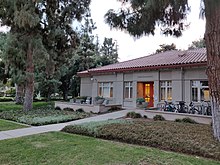
The Pomona College Career Development Office provides pre-professional opportunities. The Pomona College Internship Program (PCIP) connected 134 students in the 2014–2015 year to paid internships undertaken during the school year at 102 different organizations in Southern California. Students receive a wage as well as transportation funding. The Summer Experience Funding (SEF) program provides funding for students with unpaid or low paying summer internships, including international internships. For the 2015–2016 year, 103 students received these awards in 90 sites, including 21 international internships; destinations included the United States Department of the Treasury, United Nations, Sony Entertainment Television, Ernst & Young, American Enterprise Institute, the International Criminal Court, and the Smithsonian, as well as academic experiences at research universities including UCLA, Caltech, UC Berkeley, Carnegie Mellon, and Stanford. The Shadow a Sagehen program enables current students to shadow alumni during winter break, the Sagehens in Residence program brings alumni to speak to students on campus, and the SagePost47 program links students to young alumni on a virtual platform for mock-interviews and networking. In addition, Pomona participates in Winter Career Recruiting, which provides travel funds for students applying for full-time positions and summer internships offered by companies based in Boston, New York City, Washington DC, and Los Angeles.[134] By graduation, 89% of Pomona students have completed at least one internship experience; 70% have completed two or more.[135]
Pomona collaborates with the other Claremont Colleges and consortia such as Selective Liberal Arts College Consortium (SLAC), Career and Intership Connections (CIC), and Liberal Arts Career Network (LACN). Most career based events are five college in nature, enabling students to attend a larger diversity of events than would be available at a single liberal arts college. The online HandShake program contains over 9,100 job postings, and the LACN database contains over 13,000 postings. 175 employers hosted on-site informational events at the Claremont Colleges, 265 unique organizations were represented in 9 career fairs, and 150 employers participated in interview and on-campus recruiting specifically for Claremont College students.[134]
Outcomes
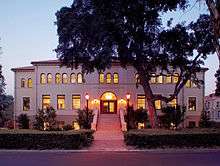
Within 10 years, 83% of Pomona graduates attend graduate and/or professional school.[126] Among Pomona applicants applying to medical school in the 2018 cycle, the percent accepted stood at 85%, more than twice the national average of 32%.[136][137] A 2016 study by College Transitions listed Pomona as among the 20 best colleges and universities for sending students to the top-ranked medical, business, and law schools per capita, as analyzed by LinkedIn profiles of alumni.[138][139][140] Pomona ranks 12th among all colleges and universities for graduates receiving doctoral degrees on a size adjusted basis from 2006–2015, as well as 12th among those receiving STEM doctoral degrees alone.[141]
Payscale ranked Pomona College 45th among colleges and universities (and 13th among liberal arts colleges) for its 2017–2018 Salary Report, with graduates earning an average early career salary of $60,600 and an average mid-career salary of $130,100.[142] Pomona has been recognized as a major contributor among small colleges sending alumni to the Teach for America program, and it ranks among the top 50 U.S. colleges and universities for producing career diplomats.[143][144] In a study on student debt produced by the Project on Student Debt for the Class of 2011, Pomona College was among the top 20 colleges and universities in the least amount of debt taken on by graduates.[145]
In a 2015 bulletin published by the Churchill Scholarship foundation, Pomona ranked as the liberal arts college with the highest number of students awarded the scholarship from 2005–2015, and fifth among all colleges and universities alone, tied with the California Institute of Technology and Carnegie Mellon University.[146] It also ranked as the liberal arts college with the largest number of students and alumni receiving National Science Foundation graduate research fellowships in 2017, with a total of 14 recipients.[147] Since 1904, 12 Pomona alumni have received Rhodes Scholarships, the third most of any California college or university after Stanford University and the University of California, Berkeley (Rhodes Scholarships are distributed equally among each state).[148] 13 Pomona alumni have received Marshall scholarships since 1954, the third highest among liberal arts colleges and within the top 40 colleges and universities overall.[149] From 2012–2017, six students and alumni received Gates Cambridge Scholarships.[150] From 2008–2017, Pomona produced the most Barry M. Goldwater Scholarship recipients of any primarily undergraduate institution, with a total of 20 students.[151][152] The college ranked second among all liberal arts colleges for students winning Fulbright Scholarships in the 2016–2017 cycle, tied with consortium member Pitzer College.[153] Out of the quarter of the Class of 2017 who applied for fellowships in their senior year, 28 students received a total of 31 awards, including 13 Fulbright awards, 2 Downing Scholars in Downing College, Cambridge, 1 Watson Fellowship, 1 Princeton in Asia Fellowship, and 2 NYU Shanghai Teaching Writing and Speaking Fellowships.[136]
Rankings
| University rankings | |
|---|---|
| National | |
| Forbes[154] | 12 |
| THE/WSJ[155] | 23 |
| Liberal arts colleges | |
| U.S. News & World Report[156] | 5 |
| Washington Monthly[157] | 8 |
The 2020 U.S. News & World Report "Best Colleges" rankings categorize Pomona as "most selective" and name it the fifth best liberal arts college in the nation, along with second for "Best Value" and tied for 25th for "Best Undergraduate Teaching".[158] Pomona has been ranked in the top 10 liberal arts colleges every year by U.S. News since it began ranking them in 1984, and is one of only five schools with such a history.[159]
In 2019, Forbes ranked Pomona 12th overall in its America's Top Colleges ranking,[13] which includes 650 military academies, national universities, and liberal arts colleges, and first among liberal arts colleges alone.[160] In 2015, it ranked Pomona first among all colleges and universities in the U.S.[161]
For 2019, Washington Monthly ranked Pomona eighth among 214 liberal arts colleges in the U.S. based on its contribution to the public good, as measured by social mobility, research, and promoting public service.[162]
The Wall Street Journal/Times Higher Education 2020 rankings rated Pomona 23rd out of over 800 U.S. colleges and universities, and 3rd among liberal arts colleges alone.[163]
Parchment ranked Pomona first among all colleges and universities in its 2017 Student Choice College Rankings, a measure of admitted students' revealed preferences among their college choices.[164]
The Princeton Review has included Pomona in several of its rankings over the last few years, including best value colleges, best classroom experience, best financial aid, best run schools, most loved schools, most accessible professors, best quality of life, happiest students, best college dorms, and best science facilities.[165][166][167]
Admissions and financial aid
Admissions
| Admissions statistics (2019)[168][169] | |
|---|---|
| Parentheses denote change since 2014. | |
| Admit rate | 7.4% ( |
| Yield rate | 54% ( |
| Test scores middle 50% | |
| SAT EBRW | 690–750 |
| SAT Math | 700–790 |
| ACT Composite | 32–35 |
| High school GPA | |
| Top 10%† | 92% ( |
| Top 25%† | 100% ( |
| †Among students whose school ranked | |
Pomona offers three routes for students to apply: the Common Application, the QuestBridge application, and the Coalition application.[170] Applicants who want an earlier, binding decision to the college can apply either Early Decision I or II; others apply through Regular Decision.
The college considers a variety of factors for the admissions process, placing greatest importance on course rigor, class rank, GPA, test scores, application essay, recommendations, extracurricular activities, talent, and character. Interviews, first generation status, geographic residence, race and ethnicity, volunteer work, and work experience are considered. Alumni relationships, religious affiliation, and level of interest are not considered.[168]
For the 2018–2019 admissions cycle, Pomona College accepted 780 students from a pool of 10,245 applicants (a 7.6% overall acceptance rate).[11] 57% of the admitted students were domestic students of color, 11.3% were international students, and 19.2% were first-generation college students. 95% were in the top decile of their class. The median SAT for admitted students was a 1495 (735 Evidence Based Reading & Writing; 760 Math), and the median ACT was a 34. Admitted students represented 47 states, District of Columbia, Puerto Rico, Guam, and 44 foreign countries; approximately a quarter were from California.[15]
.jpg)
Of transfer applicants for the 2018–2019 year, 8.2% were admitted (32 of 390 applicants).[11] The college has publicly announced an interest in identifying community college transfers who are a good fit for the school.[171]
Pomona is also a Posse Foundation partner college, and is part of many coalitions and initiatives targeted at bringing underrepresented demographics to higher education. Domestic programs include the Say Yes Education Compact, which offers full-tuition scholarships to students from urban school districts, the American Talent Initiative, a group of 86 colleges and universities seeking to "expand access and opportunity for highly-talented lower-income students", and Service to School's VetLink program, a group of 14 leading universities and liberal arts colleges seeking to support veteran applicants in the admissions process.[172][173][174] International initiatives include the Sutton Trust, which identifies high-achieving low-income students in the United Kingdom to study in U.S. colleges, Bridge2Rwanda, a non-profit seeking to increase access to U.S. colleges for Rwandan students, and the Grew Bancroft Foundation, an organization seeking to connect Japanese students to U.S. liberal arts colleges.[15][175][176]
Costs, financial aid, and socioeconomic impact
Pomona practices need-blind admission for students who are U.S. citizens, permanent residents, DACA status students, undocumented students, or who graduate from a high school within the United States, and meets 100 percent of demonstrated need for all admitted students, including admitted international students.[177][178] No loans are packaged in the financial aid package, though students can choose to borrow if so desired.[179] No merit awards or athletic scholarships are offered by Pomona.[180]
For the 2018–2019 school year, Pomona charged a sticker price (tuition, room and board, and associated fees) of $69,496. Over $50 million in need-based scholarships was awarded in 2018. Fifty-seven percent of students received a financial aid package, with an average award of $55,390. Eighty-nine international students, representing 47% of all international students enrolled at the college, received an average financial aid award of $59,477.[11] The college was named 1st in the 2017 Edition of the Princeton Review for "Best Financial Aid".[181]
Twenty-two percent of Pomona College students qualify for Pell Grants, a federal financial aid grant reserved for domestic students of the neediest backgrounds. A 2017 review among top 50 LACs (as ranked by US News & World Report) identified Pomona as having the third highest Pell population as a percent of the first year class, after Soka University of America and Vassar College.[182] According to a 2018 report by Third Way, Pomona was one of five colleges or universities (among 1566 analyzed) to graduate 100% of Pell Grant recipients within six years, considerably above the national graduation rate of this group at 51%.[183] In 2017, The New York Times listed Pomona at #8 among "Top Colleges Doing the Most for the American Dream", based on net-prices for middle-income students and Pell percentage; Amherst College and Harvard University were the only other private institutions within the top 10.[184]
People
Student body
† "Hispanic" includes Hispanics of any race. All other categories refer to non-Hispanics.
As of fall 2018, the student body consists of 1679 undergraduate students, of whom 1655 are degree-seeking students. Of degree seeking students, 52.1% of the students are female and 47.9% are male. 49.5% are domestic students of color, and an additional 11.4% are international students.[21] Current Pomona students hail from all 50 states, D.C., Puerto Rico, Guam, and 59 foreign countries.[8] The most frequent hometowns for Pomona students enrolled for the 2017–2018 year were in California (26.5%), foreign countries (15.2%), Illinois (6.1%), Washington state (4.7%), and New York (4.7%).[186] As of 2013, the median family income of Pomona students was $166,500, with 52% of students coming from the top 10% highest-earning families and 22% from the bottom 60%.[187] The college has enrolled higher numbers of low-income students in recent years, and was ranked second among all private institutions in The New York Times' 2017 College Access Index, a measure of economic diversity.[188]
The first-year class consists of 412 students. In addition, 22 transfer students matriculated. The middle 50% of enrolled first-years scored a 700–760 on the new SAT evidence based reading and writing Section, 700–780 on the new SAT math section, and 31–34 on the ACT; 91% ranked in the top 10% of their high school class, while 100% ranked in the top 25% (among students with an official class rank).[11]
For the class of 2012, 88% of students graduated within 4 years, and 94% graduated within 6 years. The retention rate for the class of 2021 was 96.90%.[11] U.S. News reported that Pomona had the highest four year graduation rate of any college or university in the U.S. for students entering in fall 2010, as well as the highest retention rate of any liberal arts college from fall 2012–2015.[189][190]
Alumni and faculty

Pomona has approximately 25,000 living alumni.[5] Of those who are working, 23.5% are in education, 23.8% are in business and finance, 10.4% are in law and government, 9.9% are in health and medicine, 4.3% are in science and technology, 5.1% are in arts and media, and 23% are in other fields.[88]
Notable alumni of Pomona College include cartographer Carl I. Wheat (1915); pioneer of Chinese social science Chen Hansheng (1920); avant-garde composer John Cage (dropped out 1930); fourteen-time Grammy-winning conductor Robert Shaw (1938); Gumby creator Art Clokey (1943); senior Disney executive Roy E. Disney (1951); writer, actor, and musician Kris Kristofferson (1958); actors Joel McCrea (1928) and Richard Chamberlain (1956); Light and Space artist James Turrell (1965); Civil Rights activist and NAACP chairman Myrlie Evers (1968); former New York Times executive editor Bill Keller (1970); self-help author Marianne Williamson (dropped out 1973); Pulitzer Prize-winning newspaper columnist Mary Schmich (1975);[191] genome editing pioneer Jennifer Doudna (1985);[192] U.S. Circuit judges James Marshall Carter (1924), Stephen Reinhardt (1951), and Richard Taranto (1977); U.S. Democratic Senators Alan Cranston of California (transferred) and Brian Schatz of Hawaii (1994); and several Academy Award-winning screenwriters, including Robert Towne (1956) and Jim Taylor (1984).
Of the 241 faculty members, 188 are full-time faculty and 53 are part-time faculty. Of full-time faculty, 60 (31.9%) are members of minority groups, 79 (42%) are women, and 186 (98.9%) have a doctorate or other terminal degree in their respective field.[193]
Notable faculty of the past and present include novelist David Foster Wallace (2002–2008),[76] former U.S. ambassadors Michael Armacost (1960s) and Cameron Munter (2013–2015), novelist Jonathan Lethem (2011–present), jazz musician Bobby Bradford (1974–present),[194] poet Claudia Rankine (2006–2015),[195] composer Fannie Charles Dillon (1910–1913), and NBA basketball coach Gregg Popovich (1979–1988).[196]
Student life
The Claremont Colleges
Pomona is a member of the Claremont Colleges, and most social activities revolve around the five colleges, or "5Cs". Pomona College, Claremont McKenna College, Scripps College, Pitzer College, and Harvey Mudd College share dining halls, libraries, and other facilities throughout the contiguous campuses. All five colleges, along with Claremont Graduate University and the Keck Graduate Institute, are part of the Claremont University Consortium. Notable benefits of being in the consortium include equal access to seven dining halls and 10 additional on-campus eateries, the fifth largest private library collection in California, interaction with over 7,000 students, access to programs such as Harvey Mudd's Clinic Program and Claremont McKenna's Semester in Washington (DC) program, and the opportunity to do a housing exchange with a student at another college.[197] Most events sponsored by each school are open to students from all of the Claremont Colleges, including invited speakers and performers, employment and recruiting events, and social events.
Campus organizations
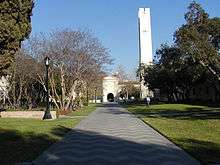
There are more than 200 clubs and organizations across the Claremont Colleges.[198]
There are several media organizations at the Claremont Colleges, including most prominently The Student Life, the oldest college newspaper in Southern California.[199] It publishes a weekly print edition as well as online content. Pomona also has a student-run radio station, KSPC. The Claremont Independent, a conservative magazine, has produced articles about the campuses' political culture that have been picked up by national conservative media outlets and drawn criticism from many students.[200][201][202][203] The Golden Antlers publishes satirical content.[204]
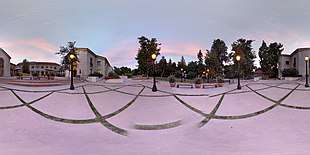
(view as a 360° interactive panorama)
The Associated Students of Pomona College (ASPC) serves as Pomona's official student government. Composed of fifteen elected representatives and numerous appointed committee members, ASPC represents Pomona's student body in discussions with the administration, provides funding for clubs and organizations, runs the Pomona Events Committee (PEC), and covers the cost of security and alcohol for social events. It also manages a New York Times subscription program and an airport ride coverage program.[205]
Pomona Events Committee (PEC) is a committee of ASPC, and creates on-campus and off-campus events for Pomona students. Some notable events include De-Stress, which provides students a relaxation period before final exams; the annual Ski Beach Day, in which students spend a day at a nearby ski resort followed by a trip to a local beach, subsidized excursions to attractions and venues in the Los Angeles region, and dances such as the Yule Ball and the Spring Formal.
The Pomona Student Union (PSU) facilitates the discussion of political and social issues on campus. They describe their mission as "promoting honest and open dialogue in order to challenge the assumptions of students and the wider campus community."[206] They hold discussions, panels, and debates with prominent speakers with the goal of stimulating conversation and creating an environment in which all viewpoints are represented. Notable speakers the PSU has brought to Pomona include Jon Meacham, Mari Matsuda, Sam Harris, Nadine Strossen, Michael Isikoff, and Slavoj Žižek.[207]
The Claremont Colleges Ballroom Dance Company (CCBDC) is one of the largest organizations on campus, with over 130 dancers. It offers dance classes on a variety of expertise levels and showcases several events and performances each year.[208] CONTRAversial, the contra dance club of the Claremont Colleges, hosts monthly dances that are open to both students and community members.[209][210] Other dance groups include the 5C Dance Company, hip-hop dance crews Groove Nation and Reverb, Tamasha (5C Bollywood Dance Company), 5C Ballet Company, Underground Blues, and 5C Freestylin' Collective.
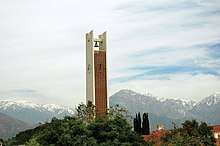
On the Loose (OTL), the outdoors club of the 5Cs, sponsors trips to outdoors destinations.[211] Its flagship event, an annual costumed hike up Mt. Baldy,[212] can draw more than 100 participants.[213] It is affiliated with the Outdoor Education Center of the Claremont Colleges (OEC), which loans equipment to students for free and provides outdoor leadership training.[214]
Pomona has numerous singing and a cappella groups, including Men's Blue and White, Women's Blue and White, the After School Specials, the Claremont Shades, Midnight Echo, the 9th Street Hooligans, Kosher Chords, and Mood Swing. It hosts the annual SCAMFest concert, which also draws in a capella singers from other Southern California universities, as well as the regional quarterfinals for the International Championship of Collegiate A Cappella. Other musical groups include the Pomona College Orchestra, Band, Choir, Glee Club, Jazz Ensemble, and Balinese Gamelan Ensemble. All Pomona College students, and Claremont College students in Pomona College ensembles, can receive private music lessons at no cost.[215] The Pomona College Theater Department leads 3–4 mainstage productions each year, and there are a number of smaller student run productions as well. The college also hosts two improv groups, Without a Box and Underground Theatrical Institute (UTI).
Pomona has two remaining local Greek organizations, Sigma Tau and Kappa Delta, both of which are co-educational.[216] Neither have special housing, and they are not considered to have a major impact on the social scene on campus akin to that of Greek organizations at many other U.S. colleges.[216]
Sagehen Capital Management, Pomona's student-run hedge fund investment club, manages assets of over one million dollars from the college's endowment.[217]
Pomona is home to numerous student support offices, which provide mentoring programs for students who identify with a particular identity. These include the Women's Union (WU), Office of Black Student Affairs (OBSA), Asian American Resource Center (AARC), Students of Color Alliance (SOCA), Chicano Latino Student Affairs (CLSA), Queer Resource Center (QRC), and the International Place of the Claremont Colleges (I-Place).[218] The low-income and first-generation community on campus, Quest Scholars, has over 160 active members and provides all incoming first year low income students with upperclassman mentors.[219] The Pomona Advocates support survivors of sexual violence and work to promote consent culture.[220]
Residential life
Pomona is a residential campus, and students must apply to live off campus. Virtually all students live on campus for all four years in one of Pomona's sixteen residence halls.[221] All first-year students live on South Campus in Mudd-Blaisdell, Harwood, Wig, Lyon, and Gibson residence halls. All incoming students are placed into a sponsor group, with 10–20 peers and two or three upperclassmen "sponsors". This tradition, dating back to 1927,[222] is meant to ease the transition to college life.[223] Most juniors and seniors live on North Campus.
Transportation
Pomona's campus is located two blocks from the Claremont Station, where the Metrolink San Bernardino Line train provides daily service to Union Station, Los Angeles. The ride from Claremont to Los Angeles takes a little under an hour, and college students are eligible to receive a 25% discount on fares. Metrolink tickets from Claremont serve as an all-day "EZ-Transit Pass", enabling users to connect to participating bus and rail lines for free for the duration of the day. This grants access to the bus and light rail system of LA Metro and LADOT, the two largest public transportation systems in the region, alongside numerous other public transportation systems.[224]

The campus is also two blocks from the Claremont Transcenter, serviced by bus system Foothill Transit. Bus lines connect to cities in the San Gabriel Valley and Pomona Valley. The nearby Montclair Transcenter provides connections to Omnitrans, the largest public transportation system in San Bernardino county, and the Foothill Transit Silver Streak, which runs to Downtown Los Angeles at least once every hour (including late-night). All Pomona students and employees receive a free Foothill Transit Class pass, enabling unlimited free rides on any Foothill Transit Bus, including the Silver Streak.[225]
The Green Bikes program at Pomona allows students to check out a bicycle free of charge for the duration of the semester, and provides free bicycle servicing and repair to all employees and students. More than 300 bicycles are available.[226]
Through the Zipcar program, students can reserve cars located on-campus for travel within 180 miles. A membership with the program is required, and hourly and daily rates apply. In addition, the college owns vehicles which can be checked out for club and extracurricular purposes, pending approval as a registered driver. PEC and Smith Campus Center off-campus events are usually served with Pomona's 34-passenger bus, the Sagecoach.[227]
Sustainability
Pomona's Board of Trustees adopted the College's first Environmental Policy in 2002.[228] The school subsequently hired its first Sustainability Coordinator in 2008 and its Sustainability Integration Office was created in 2009.[229] The College buys local and organic food for its dining halls, has undertaken a variety of outreach initiatives; requires that all new construction meet LEED Silver standards; offsets a percentage of its emissions with Renewable Energy Credits; and reduces water consumption, especially in landscaping.[230] The College was awarded an "A" for its sustainability initiatives by the Sustainable Endowments Institute in the College Sustainability Report Card 2011.[231]
Community engagement
The Draper Center for Community Partnerships, established in 2009, serves as Pomona's community engagement center.[232] The center provides students funding for summer and winter engagement, transportation costs for volunteering during the school year, leadership opportunities through which students can lead the various programs offered (known as Draper Center Coordinators), and advising for community engagement applications.[233] It also provides students, faculty, and local residents a multitude of community engagement programs, including[234] the Pomona Academy for Youth Success (PAYS), a three-year pre-college summer program for local low income and first generation students of color,[235] and Alternabreak, a week-long community engagement trip for students during Spring Break.
Athletics
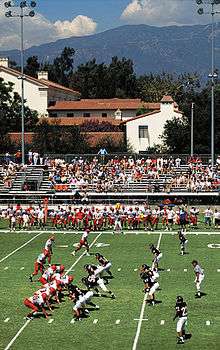
| Women's sports† | Men's sports† |
|---|---|
| Basketball | Baseball |
| Cross country | Basketball |
| Golf | Cross country |
| Lacrosse | Football |
| Soccer | Golf |
| Softball | Soccer |
| Swimming and diving | Swimming and diving |
| Tennis | Tennis |
| Track and field | Track and field |
| Volleyball | Water polo |
| Water polo | |
| † Includes only varsity sports, not intramural or club sports | |
The school's varsity athletic teams compete in conjunction with Pitzer College (another consortium member) as the Pomona-Pitzer Sagehens.[236] The 11 women's and 10 men's teams participate in NCAA Division III in the Southern California Intercollegiate Athletic Conference.[236] Pomona-Pitzer's mascot is Cecil the Sagehen, a greater sage-grouse, and its colors are blue and orange.[237] Its main rival is the Claremont-Mudd-Scripps Stags and Athenas (CMS), the other sports combination of the Claremont Colleges.
Club and intramural sports are also offered in a variety of areas, such as dodgeball, flag football, and surfing.[238] The Physical Education department offers a variety of activity classes each semester, such as karate, playground games, geocaching, and social dance.[239]
Athletic facilities at Pomona include five basketball courts, four racquetball courts, two squash courts, a weight room, an exercise room, two pools, two tennis court complexes, a football field, a track, a softball field, a baseball field, and four fields for soccer, lacrosse, ultimate frisbee, and field hockey.[240]
Athletics history
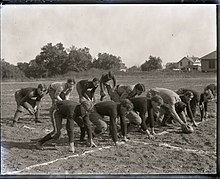
Pomona's first intercollegiate sports teams were formed in 1895.[241] They competed under a variety of names in the school's early years; the name "Sagehen" first appeared in 1913 and became the sole mascot in 1917.[242] Pomona was one of the three founding members of SCIAC in 1914, and its football team played in the inaugural game at the Los Angeles Coliseum in 1923.[241] In 1946, Pomona joined with Claremont Men's College (which would later be renamed Claremont McKenna College) to compete as Pomona-Claremont.[241] The teams separated in 1956, and Pomona's sports teams operated independently until it joined with Pitzer College in 1970.[241]
The Sagehens ranked ninth out of 446 Division III schools and second among SCIAC schools in the 2019–2020 NACDA Directors' Cup Division III Final Fall Standings, which ranks athletic programs and awards points relative to their finish in NCAA Championships.[243][244]
Traditions
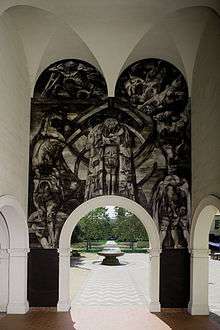
47
The number 47 has historical implications to the college.[245][246] Two different stories about its roots exist. Campus lore suggests that in 1964, Pomona math professor Donald Bentley produced a convincing mathematical proof that 47 was equal to all other integers, and that other faculty members and senior students could not disprove his equation at first sight. (By the 1970s oral history had grown this tale into a 1950s McCarthy-era exercise by an unnamed professor, and that it was a symbolic attack on the "big lie" political style of the Red-hunters of the era.) Another version — later verified by Bentley — holds that two Pomona students on a summer grant project in 1964 hypothesized that 47 occurred far more often in nature than random number distribution would explain. Pomona College is also located off exit 47 on Interstate 10.
Joe Menosky, a Pomona alumnus and writer for Star Trek: The Next Generation, incorporated the number 47 into a variety of situations in the show.[247]
The 47 tradition is endorsed by the college, as seen in Pomona College's official website's explanation of the "mystery of 47".[245] Various aspects of campus life involve 47, including a celebration every April 7.[248] In the early 2010s, Pomona's clock tower was set up to chime on the 47th minute of the hour.[249][250]
Orientation Adventure
As part of Pomona's 10-day orientation, incoming students spend four days off campus completing an "Orientation Adventure" or "OA" trip. Options in recent years have ranged from backpacking in Sequoia National Forest to sea kayaking in Channel Islands National Park. Begun in 1995, the OA program is one of the oldest outdoor orientation programs in the nation.[251]
Ski-Beach Day
Pomona College takes advantage of its location near the San Gabriel Mountains and within driving distance of the Pacific Ocean to host an annual "Ski-Beach Day" each spring. The tradition dates back to November 1891, when the college established an annual picnic in the mountains.[252] The outings began to focus on winter activities in the 1920s, and switched to a beach trip during a period of low snowfall in the 1940s, before later combining the two.[252][253] In its current form, students board a bus in the morning and are driven to a local ski resort where they ski or snowboard. After lunch, they are bused down to an Orange County or Los Angeles County beach for the rest of the day.[254]
Mufti
Rooted somewhere in the mists of the 1940s, originally the outgrowth of an unhappy group of women students protesting on-campus policies, Mufti is a secret society of punsters-as-social-commentators. Periodically their name and insignia as well as 3.5 in × 8.5 in (89 mm × 216 mm) sheets of paper are glued to walls all over campus, with double-entendre comments on local goings-on: for instance, when beloved century-old Holmes Hall was dynamited to make way for a new building in 1987, the tiny signs all over campus announced "Blast of a Century Leaves Thousands Holmesless."[255]
Further reading
- Lyon, E. Wilson (1977). The History of Pomona College, 1887-1969. The Castle Press.
References
- As of June 30, 2019. "U.S. and Canadian 2019 NTSE Participating Institutions Listed by Fiscal Year 2019 Endowment Market Value, and Percentage Change in Market Value from FY18 to FY19 (Revised)". National Association of College and University Business Officers and TIAA. Retrieved April 22, 2020.
- "Profile: Who Goes to Pomona?". Pomona College. 2019–2020. Retrieved August 13, 2020.
- "Pomona Common Data Set 2017–2018" (PDF). Pomona College. Archived (PDF) from the original on February 22, 2018. Retrieved February 21, 2018.
- Seery, John. "Somewhere Between a Jeremiad and a Eulogy" (Summer 2017). Intercollegiate Studies Institute. Archived from the original on September 26, 2018. Retrieved September 25, 2018.
- "Fact Sheet". Pomona College. May 21, 2015. Archived from the original on February 28, 2017. Retrieved September 6, 2018.
- "Archived copy" (PDF). Archived (PDF) from the original on December 22, 2015. Retrieved November 22, 2015.CS1 maint: archived copy as title (link)
- "1885 | Pomona College Timeline". Pomona College. Archived from the original on August 29, 2019. Retrieved November 3, 2019.
- "Admissions and Aid". Pomona College. February 3, 2015. Archived from the original on August 31, 2017. Retrieved January 26, 2018.
- "Fast Facts". Pomona College. May 21, 2015. Archived from the original on February 28, 2017. Retrieved February 27, 2017.
- "Top 100 - Lowest Acceptance Rates". U.S. News. Archived from the original on February 23, 2017. Retrieved October 7, 2018.
- "CDS 2018-2019". Pomona College.
- "National Liberal Arts Colleges Rankings". U.S. News & World Report. Archived from the original on August 21, 2016. Retrieved September 17, 2018.
- "America's Top Colleges List". Forbes. Archived from the original on August 10, 2016. Retrieved August 2, 2017.
- "Explore the Full WSJ/THE College Rankings". The Wall Street Journal. Archived from the original on October 6, 2018. Retrieved October 6, 2018.
- "Introducing the Pomona College Class of 2022". Pomona College. March 15, 2018. Archived from the original on March 17, 2018. Retrieved March 16, 2018.
- "Endowment per Student". College Raptor. Retrieved August 3, 2020.
- "2020 Most Diverse Colleges in America". Niche. Archived from the original on May 27, 2020. Retrieved July 11, 2020.
- "Pomona College Profile 2016–2017" (PDF). Archived from the original (PDF) on August 3, 2017. Retrieved July 25, 2017.
- "Common Data Set 2016–2017" (PDF). Pomona College. Archived (PDF) from the original on December 20, 2016. Retrieved December 8, 2016.
- "Pomona College Enrollment Statistics – Fall 2017" (PDF). Pomona College. Archived from the original (PDF) on September 16, 2017. Retrieved September 16, 2017.
- "Student Body- Fall 2018". Pomona College. April 7, 2015. Archived from the original on October 6, 2018. Retrieved October 6, 2018.
- "Pomona College". Forbes. Retrieved August 1, 2020.
- "Home | The Rhodes Scholarships". The Rhodes Trust. Archived from the original on May 23, 2013. Retrieved October 26, 2017.
- "Marshall Scholarships Statistics". Marshall Scholarships. Archived from the original on January 26, 2017. Retrieved September 16, 2017.
- "Meet the Fellows". Thomas J. Watson Foundation. Archived from the original on October 2, 2017. Retrieved October 26, 2017.
- "Top Producers of Fulbright U.S. Scholars and Students, 2018-19". The Chronicle of Higher Education. February 10, 2019. Archived from the original on April 14, 2019. Retrieved December 31, 2019.
- "Exterior view of Pomona College, Claremont, 1907 :: California Historical Society Collection, 1860-1960". digitallibrary.usc.edu. University of Southern California. Retrieved July 30, 2020.
- "1893". Pomona College Timeline. November 7, 2014. Retrieved August 10, 2020.
- "1887". Pomona College Timeline. November 7, 2014. Retrieved July 18, 2020.
- Rudolph, Frederick (1962). The American College & University: A History. Athens, Georgia: University of Georgia Press. ISBN 0-8203-1284-3.
- "1888". Pomona College Timeline. Pomona College. November 7, 2014. Retrieved August 10, 2020.
- "1906". Pomona College Timeline. November 7, 2014. Retrieved August 11, 2020.
- "1890". Pomona College Timeline. November 7, 2014. Retrieved August 10, 2020.
- "1894". Pomona College Timeline. November 7, 2014. Retrieved August 11, 2020.
- "History of Pomona College". Pomona College. September 2006. Archived from the original on September 1, 2006. Retrieved January 11, 2007.
- "1903". Pomona College Timeline. November 7, 2014. Retrieved August 11, 2020.
- "1895". Pomona College Timeline. November 7, 2014. Retrieved August 11, 2020.
- Hua, Vanessa. "To Shine in the West". Pomona College Magazine. Retrieved July 14, 2020.
- Desai, Saahil (February 5, 2016). "The Erasure of Winston M.C. Dickson, Pomona's First Black Graduate". The Student Life. Retrieved July 14, 2020.
- "1905". Pomona College Timeline. November 7, 2014. Retrieved August 11, 2020.
- "1911". Pomona College Timeline. November 7, 2014. Retrieved August 12, 2020.
- "1912". Pomona College Timeline. November 7, 2014. Retrieved August 12, 2020.
- "1913". Pomona College Timeline. November 7, 2014. Retrieved August 12, 2020.
- "1921". Pomona College Timeline. November 7, 2014. Retrieved August 1, 2020.
- "1900". Pomona College Timeline. November 7, 2014. Retrieved August 11, 2020.
- "1902". Pomona College Timeline. November 7, 2014. Retrieved August 11, 2020.
- "1916". Pomona College Timeline. November 7, 2014. Retrieved August 12, 2020.
- "1917". Pomona College Timeline. Pomona College. November 7, 2014. Retrieved August 3, 2020.
- "History of the Claremont Colleges". Claremont University Consortium. Archived from the original on February 5, 2007. Retrieved January 11, 2007.
- "A Brief History of Pomona College". Pomona College. March 19, 2015. Archived from the original on July 15, 2018. Retrieved October 26, 2017.
- "1928". Pomona College Timeline. November 7, 2014. Retrieved August 12, 2020.
- "1929". Pomona College Timeline. November 7, 2014. Retrieved August 12, 2020.
- "1943". Pomona College Timeline. November 7, 2014. Retrieved August 13, 2020.
- "1932". Pomona College Timeline. November 7, 2014. Retrieved August 12, 2020.
- "1934". Pomona College Timeline. November 7, 2014. Retrieved August 12, 2020.
- "1941". Pomona College Timeline. November 7, 2014. Retrieved August 13, 2020.
- "1942". Pomona College Timeline. November 7, 2014. Retrieved August 13, 2020.
- "1944". Pomona College Timeline. November 7, 2014. Retrieved August 13, 2020.
- "1947". Pomona College Timeline. November 7, 2014. Retrieved August 13, 2020.
- "1958". Pomona College Timeline. November 7, 2014. Retrieved August 13, 2020.
- Sterman, Paul (November 14, 2012). "The Man with a Plan". The Pomona Plan. Pomona College. Retrieved August 11, 2020.
- "Pomona Plan Book 2017" (PDF). Pomona College. Retrieved August 13, 2020.
- "1957". Pomona College Timeline. November 7, 2014. Retrieved August 13, 2020.
- Desai, Saahil; Tidmarsh, Kevin. "Episode 5: "Farewell To Pomona"". Hidden Pomona. Retrieved August 13, 2020.
- Breslow, Samuel (February 15, 2017). "Ye Olde Student Life: Pomona Rebels Against Japanese Internment". The Student Life. Retrieved August 13, 2020.
- "1952". Pomona College Timeline. November 7, 2014. Retrieved August 13, 2020.
- "1968". Pomona College Timeline. November 7, 2014. Retrieved August 13, 2020.
- "1967". Pomona College Timeline. November 7, 2014. Retrieved August 13, 2020.
- Stein, Harry (April 5, 2016). "How My Friends and I Wrecked Pomona College". City Journal. Retrieved August 15, 2020.
- "1969". Pomona College Timeline. November 7, 2014. Retrieved August 14, 2020.
- Desai, Saahil; Tidmarsh, Kevin. "Hidden Pomona Episode 2: "When Carnegie Was Bombed"". Soundcloud. Archived from the original on November 18, 2018. Retrieved October 8, 2018.
- "PASSINGS: David Alexander, James E. Akins, Sumbat Lapajian, Carl Gordon". Los Angeles Times. July 27, 2010. Retrieved August 14, 2020.
David Alexander, 77, who brought national standing to Pomona College during a two-decade tenure as president, died Sunday
- Fiske, Edward B. (June 15, 2019). Fiske Guide to Colleges 2020 (36th ed.). Naperville, Illinois: Sourcebooks. p. 154. ISBN 9781492664949.
Pomona College, located just 35 miles east of the glitz and glamour of Hollywood, is the undisputed star of the Claremont Colleges and one of the top small liberal arts colleges anywhere. This small, elite institution is the top liberal arts college in the West.
- "1984". Pomona College Timeline. November 7, 2014. Retrieved August 14, 2020.
- "Campus Life: Pomona; Fraternity Rooms To Be Converted Into Lounges". The New York Times. March 24, 1991. Archived from the original on October 10, 2018. Retrieved October 10, 2018.
- "2008". Pomona College Timeline. November 7, 2014. Retrieved August 14, 2020.
- "Sustainability timeline". Pomona College. April 7, 2015. Retrieved August 14, 2020.
- "2006". Pomona College Timeline. November 7, 2014. Retrieved August 14, 2020.
- Lorin, Janet Frankston (August 25, 2009). "Endowment Losses Threaten No-Loan Policies as Guarantees Vanish". Bloomberg. Retrieved August 14, 2020.
- "Archived copy". Archived from the original on November 28, 2010. Retrieved February 6, 2011.CS1 maint: archived copy as title (link)
- Medina, Jennifer (February 1, 2012). "Immigrant Worker Firings Unsettle Pomona College". The New York Times. Archived from the original on April 9, 2017. Retrieved February 28, 2017.
- Pope, Laney (March 2, 2018). "Pomona's DACA Advocacy Contrasts With 2011 Firing Of Undocumented Workers". The Student Life. Retrieved July 14, 2020.
- Zalesin, Jeff (December 2, 2011). "17 Employees Terminated Over Documents; Boycott, Vigil Extended". The Student Life. Retrieved July 14, 2020.
- Haas, Wes (May 3, 2013). "WFJ Votes to Unionize". The Student Life. Retrieved July 14, 2020.
- Breslow, Samuel (April 29, 2016). "Looking Back On Pomona's Rebranding". The Student Life. Retrieved August 14, 2020.
- "The Office of President G. Gabrielle Starr". May 22, 2015. Archived from the original on December 29, 2016. Retrieved December 9, 2016.
- Rod, Marc (October 18, 2017). "G. Gabrielle Starr Inaugurated As 10th President Of Pomona College". The Student Life. Archived from the original on October 31, 2018. Retrieved October 31, 2018.
- "Pomona Profile Archived 2012-10-28 at the Wayback Machine" Pomona College. Retrieved August 15, 2013.
- "Pomona College 2015 Master Plan" (PDF). Pomona College. Retrieved August 11, 2020.
- Anderson, Seth (December 14, 2007). "James Blaisdell and the Claremont Colleges". Claremont Graduate University. Archived from the original on September 28, 2007. Retrieved January 11, 2007.
- Peterson, William (2002). "CB Fisk #117 Pomona College, Claremont, CA". C.B. Fisk, Inc. Archived from the original on June 23, 2007. Retrieved January 11, 2007.
- "Residence Halls – South Campus". Pomona College. Archived from the original on September 1, 2006. Retrieved January 11, 2007.
- "Oldenborg "The Borg" Center – Pomona College". Pomona College. Archived from the original on February 23, 2012. Retrieved February 16, 2012.
- "About Bridges Auditorium". Claremont University Consortium. Archived from the original on February 2, 2007. Retrieved January 11, 2007.
- "Collections". Pomona College Museum of Art. Archived from the original on April 4, 2017. Retrieved April 4, 2017.
- "1914". Pomona College Timeline. November 7, 2014. Retrieved July 30, 2020.
- Guan, Michelle (April 27, 2012). "Pomona Chooses Student Speakers for Class Day, Commencement". The Student Life. Retrieved July 30, 2020.
- "Campus Facilities". Pomona College Catalog. Pomona College. Retrieved August 2, 2020.
- "Pomona College's Studio Art Hall Wins National Steel Building Award". AISC. November 4, 2015. Archived from the original on November 17, 2015. Retrieved November 15, 2015.
- Hawthorne, Christopher (January 9, 2015). "Review: Compelling case for gray at Pomona College's Studio Art Hall". Los Angeles Times. Retrieved July 30, 2020.
- Tiffany, Laura. "New Parking Structure Part of a Larger Vision for a Greener, More Pedestrian-Friendly Campus Archived 2013-08-07 at the Wayback Machine" July 6, 2011. Retrieved August 15, 2013.
- "Richard C. Seaver Biology Building". Pomona College Biology Department. Archived from the original on August 1, 2007. Retrieved January 11, 2007.
- "$25 Million Gift Establishes Center for Creativity and Collaboration for the 5Cs". Pomona College. September 10, 2015. Archived from the original on November 17, 2015. Retrieved November 15, 2015.
- "Winning Gold". Pomona College Magazine. Archived from the original on May 13, 2008. Retrieved March 12, 2008.
- "Lincoln Edmunds Receives Gold". The Student Life. Retrieved March 12, 2008.
- "Night Rite". Pomona College Magazine. Archived from the original on May 9, 2008. Retrieved March 12, 2008.
- "Dedication Held For Turrell Skyspace Exhibition". The Student Life. Archived from the original on May 28, 2007. Retrieved March 12, 2008.
- Peters, Cynthia. "Pomona College Celebrates Opening of Two of the Nation's Greenest Residence Halls. Archived 2013-08-07 at the Wayback Machine" September 21, 2011. Retrieved August 15, 2013.
- "New Millikan Laboratory and Andrew Science Hall Certified LEED Platinum". Archived from the original on November 17, 2015. Retrieved November 15, 2015.
- "Pomona College Timeline: 1908". Pomona College. November 7, 2014. Archived from the original on May 17, 2019. Retrieved May 17, 2019.
- "Residence Halls – North Campus". Pomona College. Archived from the original on September 1, 2006. Retrieved January 11, 2007.
- Peters, Cynthia. "Pomona College Buys Trails End Ranch For New Field Station with Plans to Preserve the 50 Wilderness Acres Archived 2013-08-07 at the Wayback Machine" July 24, 2012. Retrieved August 15, 2013.
- "Trails End Ranch". Pomona College. April 7, 2015. Retrieved July 30, 2020.
- "Halona Lodge and Retreat Center". Pomona College in Claremont, California - Pomona College. April 7, 2015. Retrieved July 30, 2020.
- "1931". Pomona College Timeline. November 7, 2014. Retrieved August 15, 2020.
- "Table Mountain Observatory". Pomona College in Claremont, California - Pomona College. January 18, 2017. Retrieved July 30, 2020.
- "Honnold/Mudd Library: A Brief History Archived February 2, 2012, at the Wayback Machine" Retrieved August 15, 2013.
- "Degree Requirements & Academic Regulations". Pomona Course Catalog. Pomona College. Archived from the original on February 24, 2017. Retrieved February 24, 2017.
- "By the Numbers: Pomona College Academics Archived 2012-10-16 at the Wayback Machine"
- "Pomona Preview 2013 Archived 2013-08-30 at the Wayback Machine" p. 4, 11. Retrieved August 15, 2013.
- "The Claremont Colleges". May 21, 2015. Archived from the original on July 8, 2017. Retrieved August 20, 2017.
- "Independent Study". Archived from the original on August 20, 2017. Retrieved August 20, 2017.
- "Majors and Minors". Reports and Statistics. Pomona College. April 7, 2015. Archived from the original on April 21, 2016. Retrieved November 29, 2017.
- "Special Programs and Opportunities". Pomona College. Archived from the original on December 28, 2016. Retrieved December 27, 2016.
- "Collaborating Colleges & Universities". HBX. Harvard Business School. Archived from the original on December 28, 2016. Retrieved December 27, 2016.
- "Fast Facts". Pomona College. Pomona College. Archived from the original on December 1, 2017. Retrieved November 30, 2017.
- "Study Abroad". Study Abroad. Pomona College. May 22, 2015. Archived from the original on July 16, 2018. Retrieved February 13, 2018.
- "Special Programs and Opportunities". Archived from the original on August 20, 2017. Retrieved August 20, 2017.
- "Pomona College". College Completion. The Chronicle for Higher Education. Archived from the original on March 27, 2017. Retrieved March 1, 2017.
- "By the Numbers". Pomona College. Archived from the original on October 16, 2012. Retrieved October 14, 2012.
- "Research at Pomona Archived 2013-08-07 at the Wayback Machine" Retrieved August 15, 2013.
- "Campaign Progress Archived 2013-08-18 at the Wayback Machine" Retrieved August 15, 2013.
- "Where Great Research Meets Great Teaching". The Wall Street Journal. Archived from the original on March 2, 2017. Retrieved March 1, 2017.
- "Where Do Grads Go '15–'16" (PDF). Pomona College. Archived from the original (PDF) on December 27, 2016. Retrieved December 27, 2016.
- "Learn More". Pomona College. June 8, 2015. Archived from the original on December 1, 2017. Retrieved November 30, 2017.
- "After Pomona". April 4, 2016. Archived from the original on August 19, 2017. Retrieved August 19, 2017.
- "Why Pomona?". June 8, 2015. Archived from the original on September 4, 2018. Retrieved October 6, 2018.
- "Top Feeders: MBA". College Transitions. May 18, 2016. Archived from the original on March 27, 2017. Retrieved March 26, 2017.
- "Top Feeders – Medical School Programs". College Transitions. May 5, 2016. Archived from the original on March 27, 2017. Retrieved March 26, 2017.
- "Top Lawyer Producer Schools – Infographic". College Transitions. April 2, 2016. Archived from the original on March 27, 2017. Retrieved March 26, 2017.
- "Doctorates Awarded". Swarthmore College. July 8, 2014. Archived from the original on September 9, 2017. Retrieved September 16, 2017.
- "2017–2018 College Salary Report". Payscale. Archived from the original on September 14, 2017. Retrieved September 12, 2017.
- "Teach For America Announces Colleges And Universities Contributing Most Alumni To Its 25th Teaching Corps". Teach for America. Archived from the original on September 17, 2017. Retrieved September 17, 2017.
- "International Relations Program". Pomona College. May 22, 2015. Archived from the original on September 17, 2017. Retrieved September 17, 2017.
- "Student Debt and the Class of 2012" (PDF). Project on Student Debt. 2012. Archived (PDF) from the original on January 11, 2018. Retrieved September 17, 2017.
- "The "Hot" Top 10 Most Churchill Scholars (Last 10 Years)" (PDF): 6. Archived from the original (PDF) on April 20, 2017. Retrieved August 19, 2017. Cite journal requires
|journal=(help) - "Graduate Research Fellowship Program Awardee List". Note: Downloadable excel sheet at bottom of the link shows full list and enables sorting. Archived from the original on August 21, 2017. Retrieved August 20, 2017.
- "Number of Winners by Institution: U.S. Rhodes Scholars 1904-2019" (PDF). Rhodes Scholarship. Archived (PDF) from the original on November 25, 2019. Retrieved October 13, 2019.
- "US Institutions that have received Marshall Scholarships 1954–2019". Marshall Scholarship. Archived from the original on October 13, 2019. Retrieved October 13, 2019.
- "Find a Scholar". October 19, 2014. Archived from the original on August 20, 2017. Retrieved August 20, 2017.
- "Calvin Remains National Leader in Goldwater Scholars". 2016. Archived from the original on July 15, 2018. Retrieved August 20, 2017.
Calvin College has now successfully nominated 18 Goldwater Scholars since 2008. Pomona College in California is the only other primarily undergraduate institution to have as many Goldwaters during that span of time.
- "2017 Goldwater Scholars". Archived from the original on July 6, 2017. Retrieved August 20, 2017.
- "Pomona College Is No. 2 Producer of Fulbright Students Among Bachelor's Institutions". February 21, 2017. Archived from the original on August 19, 2017. Retrieved August 19, 2017.
- "America's Top Colleges 2019". Forbes. Retrieved August 15, 2019.
- "U.S. College Rankings 2020". Wall Street Journal/Times Higher Education. Retrieved September 26, 2019.
- "Best Colleges 2020: National Liberal Arts Colleges Rankings". U.S. News & World Report. Retrieved September 8, 2019.
- "2019 Liberal Arts Rankings". Washington Monthly. Retrieved September 8, 2019.
- "Pomona College Rankings". U.S. News & World Report. Archived from the original on December 13, 2018. Retrieved September 26, 2019.
- Rieter, Andrew. "U.S. News & World Report Historical Liberal Arts College and University Rankings". Data Sets. Archived from the original on September 16, 2017. Retrieved September 16, 2017.
- "America's Top Colleges 2019". Forbes. August 15, 2019. Archived from the original on October 28, 2011. Retrieved August 3, 2017.
- "Pomona College Ranks No. 1 on Forbes' 8th Annual Rankings Of America's Top Colleges". Forbes. July 29, 2015. Archived from the original on May 3, 2017. Retrieved September 16, 2017.
- "2019 Liberal Arts College Rankings". Washington Monthly. Archived from the original on September 27, 2019. Retrieved September 26, 2019.
- "Wall Street Journal/Times Higher Education College Rankings 2020". Archived from the original on September 25, 2019. Retrieved September 26, 2019.
- "Mission-Oriented Colleges Prove Top Student Choice in Sixth Annual Parchment Student Choice College Rankings". Archived from the original on July 15, 2018. Retrieved December 18, 2016.
- "The Princeton Review and USA Today Present the Princeton Review's List of "Best Value Colleges for 2013" Archived August 10, 2013, at the Wayback Machine
- Tiffany, Laura. "Pomona College Ranked in Top 10 by Princeton Review for Financial Aid, Smooth Operations and Student Appreciation". Pomona College. Archived from the original on October 16, 2012. Retrieved October 14, 2012.
- Tiffany, Laura. "Pomona College Ranked in Top 10 by Princeton Review for Financial Aid, Smooth Operations and Student Appreciation Archived October 16, 2012, at the Wayback Machine" Published August 21, 2013. Retrieved August 11, 2013.
- "Pomona College 2019-2020 Common Data Set". Pomona College. Retrieved July 14, 2020.
- "Pomona College 2014-2015 Common Data Set" (PDF). Pomona College. Retrieved August 20, 2017.
- "First-Year Applicants". Pomona College. March 19, 2015. Archived from the original on February 26, 2017. Retrieved February 25, 2017.
- "Pomona College to Increase Low-Income Students and Community College Transfer Students in Response to White House Initiative". January 16, 2014. Archived from the original on December 21, 2015.
- Peters, Cynthia (September 18, 2013). "Pomona College Joins the Say Yes Higher Education Compact". Archived from the original on December 3, 2013. Retrieved December 1, 2013.
- Seltzer, Rick. "Looking for Low-Income Students". Inside Higher Ed. Archived from the original on December 21, 2016. Retrieved December 18, 2016.
- "Service to School Announces Six New Partner Schools as VetLink Grows". Service to School. November 10, 2017. Archived from the original on December 15, 2017. Retrieved December 15, 2017.
- "About Bridge2Rwanda". Archived from the original on December 15, 2017. Retrieved December 15, 2017.
- "Grew Bancroft Foundation". Archived from the original on December 16, 2017. Retrieved December 15, 2017.
- "Global Pomona: Guide to International Admissions at Pomona College" (PDF). Pomona College. 2013. Archived from the original (PDF) on June 12, 2013.
- "Undocumented and DACA Applicants". Pomona College Admissions. Archived from the original on October 30, 2014. Retrieved October 30, 2014.
- "A Commitment to Need-Based Financial Aid". Pomona College Financial Aid. Archived from the original on December 3, 2013. Retrieved December 1, 2013.
- "Pomona Common Data Set, Financial Aid" (PDF). Archived from the original (PDF) on November 11, 2013. Retrieved November 11, 2013.
- "The Princeton Review Ranks Pomona No. 1 in Best Financial Aid". Pomona College. January 31, 2017. Archived from the original on March 2, 2017. Retrieved March 1, 2017.
- Anderson, Nick. "Pell Grant shares at top-ranked colleges: A sortable chart". The Washington Post. Archived from the original on January 7, 2018. Retrieved May 3, 2018.
- Whistle, Wesley; Hiler, Tamara. "The Pell Divide: How Four-Year Institutions are Failing to Graduate Low- and Moderate-Income Students". Third Way. Archived from the original on May 3, 2018. Retrieved May 3, 2018.
- "Top Colleges Doing the Most for the American Dream". The New York Times. Archived from the original on April 24, 2018. Retrieved May 3, 2018.
- "Student Body". Pomona College. April 7, 2015. Retrieved August 5, 2020.
- "2017–2018 Profile" (PDF). July 14, 2015. Archived (PDF) from the original on November 20, 2018. Retrieved November 20, 2018.
- Aisch, Gregor; Buchanan, Larry; Cox, Amanda; Quealy, Kevin (January 18, 2017). "Economic diversity and student outcomes at Pomona". The New York Times. Retrieved August 9, 2020.
- "Top Colleges Doing the Most for the American Dream". The New York Times. May 25, 2017. Retrieved August 15, 2020.
- "Highest 4-Year Graduation Rates". US News. Archived from the original on September 15, 2017. Retrieved September 16, 2017.
- "Freshman Retention Rate National Liberal Arts Colleges". US News. Archived from the original on September 16, 2017. Retrieved September 16, 2017.
- Sneha Abraham (April 16, 2012). "Mary Schmich '75 Wins 2012 Pulitzer Prize for Commentary". Pomona College. Archived from the original on April 11, 2015.
- Pollack, Andrew (May 11, 2015). "Jennifer Doudna, a Pioneer Who Helped Simplify Genome Editing". New York Times. Retrieved May 12, 2015.
- "Common Data Set '16–'17" (PDF). Pomona College. Archived (PDF) from the original on December 20, 2016. Retrieved December 8, 2016.
- "Bobby Bradford". Pomona College. June 1, 2015. Retrieved July 29, 2020.
- "Claudia Rankine". MacArthur Foundation. Retrieved July 29, 2020.
- Kim, Matthew; Browning, Kellen (May 6, 2020). "Long before NBA titles, Spurs' Popovich says he 'fell in love' with DIII lifestyle at Pomona-Pitzer". The Student Life. Retrieved July 29, 2020.
- "Pitzer Road Piece" (PDF). Pitzer College. Archived (PDF) from the original on September 16, 2017. Retrieved September 16, 2017.
- "Campus Organizations". Claremont Campus Labs. Archived from the original on August 20, 2017.
- "About TSL". The Student Life. Archived from the original on March 28, 2018. Retrieved March 20, 2018.
- "About Us". Claremont Independent. Archived from the original on August 20, 2017. Retrieved August 20, 2017.
- Editorial Board. "No More Clickbait, Please". The Student Life. Archived from the original on October 10, 2016. Retrieved September 24, 2016.
- Brooks, Liam. "I'm [sic] Of How the Claremont Independent Belittles Its Sources". Medium. Archived from the original on September 25, 2016. Retrieved September 24, 2016.
- Coleman, Libby. "The College Conservative Calling Out His Classmates". Ozy. Archived from the original on September 26, 2016. Retrieved September 24, 2016.
- "About Us". The Golden Antlers. October 2, 2012. Archived from the original on September 22, 2016. Retrieved September 24, 2016.
- "The Associated Students of Pomona". Archived from the original on May 11, 2013. Retrieved May 24, 2013.
- "About Us". Pomona Student Union. Archived from the original on September 27, 2016. Retrieved September 24, 2016.
- Larson, Amanda (March 3, 2017). "Slavoj Žižek Discusses Applications of Philosophy". The Student Life. Archived from the original on May 17, 2019. Retrieved May 17, 2019.
- "CCBDC". CCBDC. Archived from the original on May 29, 2013. Retrieved May 24, 2013.
- "About Us". CONTRAversial. Archived from the original on September 26, 2016. Retrieved September 24, 2016.
- Dominguez, Danielle. "5C Contra Community Dance Club Combines Tradition and Fun". The Student Life. Archived from the original on October 10, 2016. Retrieved September 24, 2016.
- "On the Loose". Archived from the original on August 14, 2012. Retrieved August 28, 2012.
- Wu, Pei Pei Barth (September 28, 2018). "Outdoors club brings back Mt. Baldy hike with emphasis on inclusivity". The Student Life. Retrieved August 3, 2020.
- Larson, Nicole (October 7, 2016). "OTL, Outdoor Club Cancels Speedo Hike to Increase Inclusivity". The Student Life. Retrieved August 3, 2020.
In previous years, at least 100 went on the Speedo Hike each year
- Haas, Wes (April 19, 2013). "Outdoor Education Center and On The Loose Clash Over Control". The Student Life. Retrieved August 3, 2020.
- "Private music lessons at Pomona College". Pomona College. April 2, 2015. Archived from the original on September 30, 2017. Retrieved March 26, 2017.
- Song, Karen (March 1, 2018). "Not Your Typical Fraternity: Getting To Know Pomona College's Sigma Tau". Archived from the original on October 10, 2018. Retrieved October 10, 2018.
- "About Sagehen Capital Management". Archived from the original on January 31, 2018. Retrieved January 31, 2018.
- "Student Support Offices". Pomona College. Archived from the original on June 12, 2013. Retrieved May 24, 2013.
- Jalal, Muhammad. "Pomona College Quest Scholars". Archived from the original on August 8, 2014. Retrieved August 2, 2014.
- "Pomona Advocates". Archived from the original on September 27, 2016. Retrieved September 24, 2016.
- "Residence Halls at Pomona College Archived August 10, 2013, at the Wayback Machine" Retrieved August 15, 2013.
- "1927". Pomona College Timeline. November 7, 2014. Retrieved August 1, 2020.
- "Sponsor Groups Archived August 18, 2013, at the Wayback Machine" Retrieved August 15, 2013.
- "Transit Connections". Metrolink. Archived from the original on February 1, 2018. Retrieved January 31, 2018.
- "Class Pass". Foothill Transit. Archived from the original on January 31, 2018. Retrieved January 31, 2018.
- "Green Bikes". Pomona College. April 7, 2015. Archived from the original on February 1, 2018. Retrieved January 31, 2018.
- "Transportation Options". Pomona College. April 7, 2015. Archived from the original on February 1, 2018. Retrieved January 31, 2018.
- "History of Sustainability at Pomona College". Pomona College. Archived from the original on September 27, 2011. Retrieved June 5, 2009.
- "Sustainability Integration Office". Pomona College. Archived from the original on September 27, 2011. Retrieved June 5, 2009.
- "Current Sustainability Efforts" (PDF). Pomona College. Archived from the original (PDF) on February 21, 2012. Retrieved June 5, 2009.
- "Pomona College – Green Report Card 2011". Greenreportcard.org. June 30, 2012. Archived from the original on January 25, 2013. Retrieved January 25, 2013.
- "The Draper Center – Who We Are Archived August 18, 2013, at the Wayback Machine" Retrieved August 15, 2013.
- "Funding Archived August 18, 2013, at the Wayback Machine" Retrieved August 15, 2013.
- "Programs Archived August 18, 2013, at the Wayback Machine" Retrieved August 15, 2013.
- "What is PAYS? Archived August 18, 2013, at the Wayback Machine" Retrieved August 15, 2013.
- "Pomona-Pitzer Sagehens". Pomona-Pitzer Sagehens. Archived from the original on January 28, 2017. Retrieved September 3, 2018.
- "Cecil Image and Athletics Color Usage Guidelines". Pomona College. June 13, 2017. Retrieved July 26, 2020.
- "Pomona Pitzer Archived January 28, 2017, at the Wayback Machine" Retrieved January 21, 2017.
- "Department of Physical Education Archived August 8, 2013, at the Wayback Machine" Retrieved August 15, 2013.
- "Facilities" Retrieved August 15, 2013.
- "Athletic History". Sagehen Athletics. Archived from the original on August 18, 2018. Retrieved August 17, 2018.
- "The History of Cecil the Sagehen". Pomona-Pitzer. Retrieved July 27, 2020.
- "2019-20 Learfield IMG College Directors' Cup Division III Fall Standings As of December 24, 2019" (PDF). National Association of Collegiate Directors of Athletics.
- "Division III 2019-20 Facts and Figures" (PDF). NCAA. Retrieved July 29, 2020.
- "Mystery of 47". Archived from the original on July 22, 2010. Retrieved July 16, 2010.
- "1964". Pomona College Timeline. November 7, 2014. Retrieved August 13, 2020.
- "Star Trek The Next Generation: The 47 Conspiracy". YouTube. Archived from the original on June 18, 2018. Retrieved August 14, 2018.
- "4/7 Celebration of Sagehen Impact". Pomona College. Archived from the original on July 31, 2019. Retrieved July 31, 2019.
- Rowan, Brendan (November 5, 2010). "Clock Tower Bell Set to Chime On the 47th Minute". The Student Life. Archived from the original on July 31, 2019. Retrieved July 31, 2019.
- "Tower's bell ringing again at Pomona College". Los Angeles Daily News. November 7, 2010. Archived from the original on July 31, 2019. Retrieved July 31, 2019.
- "Orientation Adventure". Pomona College. May 22, 2015. Archived from the original on December 24, 2018. Retrieved December 23, 2018.
- "1891". Pomona College Timeline. November 7, 2014. Retrieved July 16, 2020.
- "Pomona College Magazine :: PCM Online". September 5, 2005. Archived from the original on September 5, 2005. Retrieved July 14, 2020.
- "Pomona.edu". Archived from the original on July 5, 2008.
- "Catch Us If You Can". Soundcloud. Archived from the original on December 20, 2016. Retrieved December 14, 2016.
External links
| Wikimedia Commons has media related to Pomona College. |
.jpg)